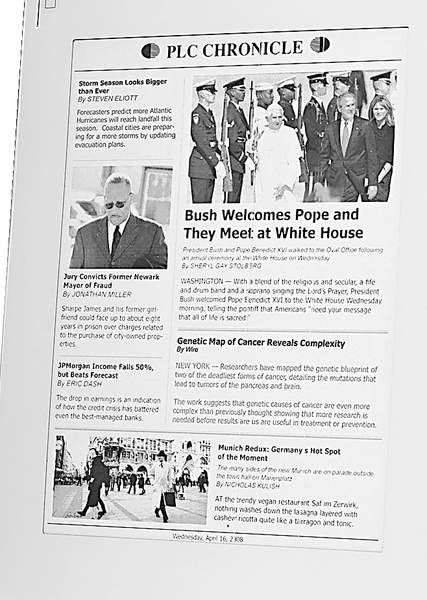A new e-newspaper has a traditional look
Published 5:00 am Monday, September 8, 2008

- The Plastic Logic reader has a screen the size of a sheet of paper for a copy machine — big enough to display a newspaper-like layout. The as-yet unnamed device would be continually updated via a wireless connection. The company plans to begin selling it in the first half of next year.
CAMBRIDGE, Mass. — The electronic newspaper, a large portable screen that is constantly updated with the latest news, has been a prop in science fiction for ages. It also figures in the dreams of newspaper publishers struggling with rising production and delivery costs, lower circulation and decreased ad revenue from their paper product.
While the dream device remains on the drawing board, Plastic Logic will introduce publicly today its version of an electronic newspaper reader: a lightweight plastic screen that mimics the look — but not the feel — of a printed newspaper.
Trending
The device, which is unnamed, uses the same technology as the Sony eReader and Amazon .com’s Kindle, a highly legible black-and-white display developed by the E Ink Corp. While both of those devices are intended primarily as book readers, Plastic Logic’s device, which will be shown at an emerging technology trade show in San Diego, has a screen more than twice as large. The size of a piece of copier paper, it can be continually updated via a wireless link, and can store and display hundreds of pages of newspapers, books and documents.
Richard Archuleta, the chief executive of Plastic Logic, said the display was big enough to provide a newspaperlike layout. “Even though we have positioned this for business documents, newspapers is what everyone asks for,” Archuleta said.
The reader will go on sale in the first half of next year. Plastic Logic will not announce which news organization will display its articles on it until the International Consumer Electronics Show in Las Vegas in January, when it will also reveal the price.
Kenneth Bronfin, president of Hearst Interactive Media, said, “We are hopeful that we will be able to distribute our newspaper content on a new generation of larger devices sometime next year.” While he would not say what device the company’s papers would use, he said, “we have a very strong interest in e-newspapers. We’re very anxious to get involved.”
The Hearst Corp., the parent of Hearst Interactive Media, owns 16 daily newspapers, including the Houston Chronicle, the San Antonio Express and the San Francisco Chronicle, and was an early investor in E Ink. The company already distributes electronic versions of some papers on the Amazon Kindle.
Newspaper companies have watched the technology closely for years. The ideal format, a flexible display that could be rolled or folded like a newspaper, is still years off, says E Ink. But it foresees color displays with moving images and interactive clickable advertising coming in only a few more years, according to Sriram Peruvemba, vice president of marketing for E Ink.
Trending
E Ink expects that within the next few years it will be able to create technology that allows users to write on the screen and view videos. In a recent demonstration at E Ink’s headquarters here, the company showed prototypes of flexible displays that can create rudimentary colors and animated images. “By 2010, we will have a production version of a display that offers newspaperlike color,” Peruvemba said.
IRex Technologies in Eindhoven, the Netherlands, is another company that makes an electronic reading device. Its iLiad is an 8.5-by-6.1-inch electronic reader that can be used to receive electronic versions of the newspaper Les Echos in France and NRC Handelsblad in the Netherlands.
The iLiad, Kindle and eReader prove the technology works. The big question for newspaper companies is how much people will pay for a device and the newspaper subscription for it.
Why newspapers stand to benefit
If e-newspapers take off, the savings could be hefty. At the San Francisco Chronicle, for example, print and delivery amount to 65 percent of the paper’s fixed expenses, Bronfin said.
With electronic readers, publishers would also learn more about its readers. With paper copy subscriptions, newspapers know what address has received a copy and not much else. About those customers picking up a copy on the newsstand, they know nothing.
As an electronic device, newspapers can determine who is reading their paper and even which articles are being read. Advertisers would be able to understand their audience and direct advertising to its likeliest customers.
While this raises privacy concerns, “these are future possibilities which we will explore,” said Hans Brons, chief executive of iRex Technologies in Eindhoven, the Netherlands.








